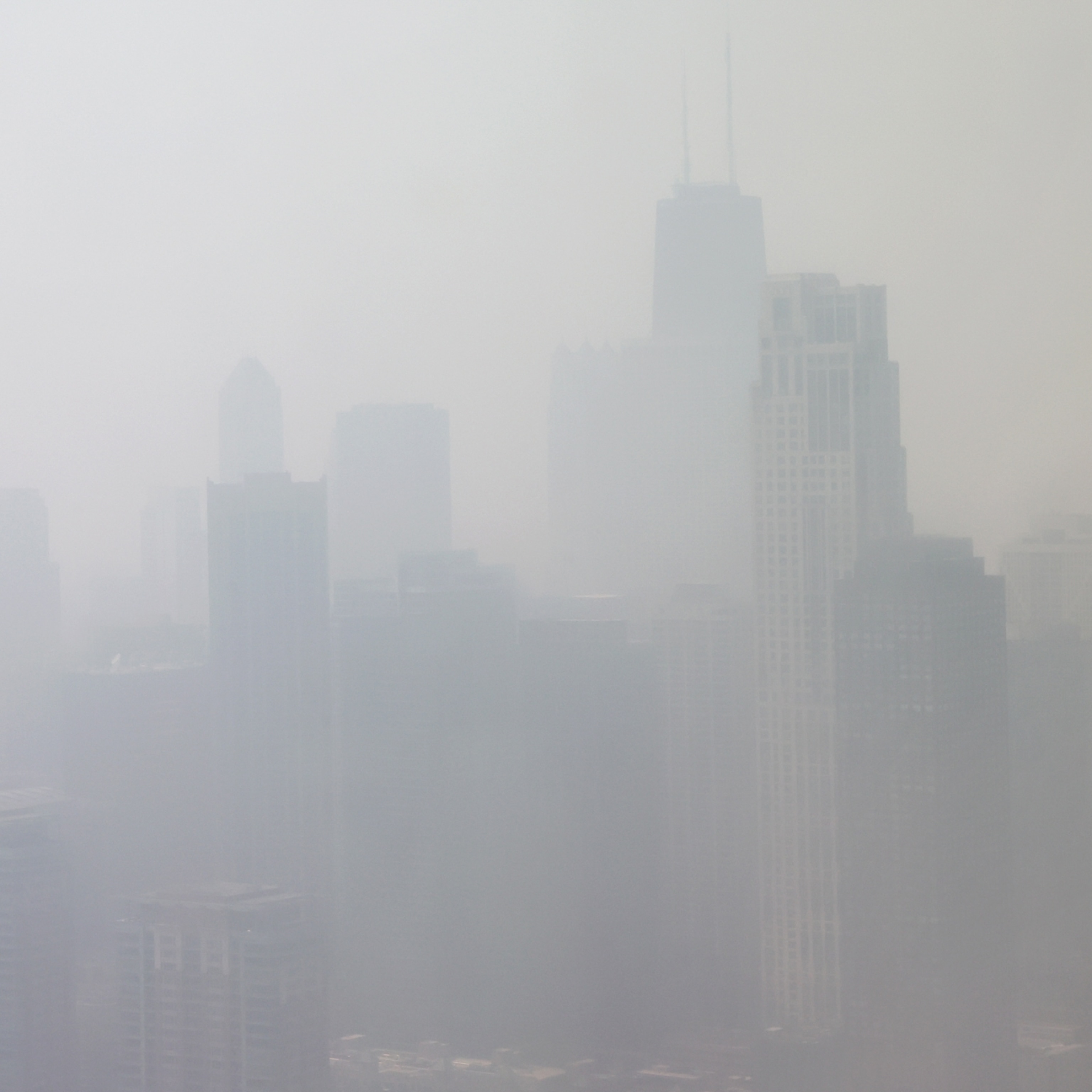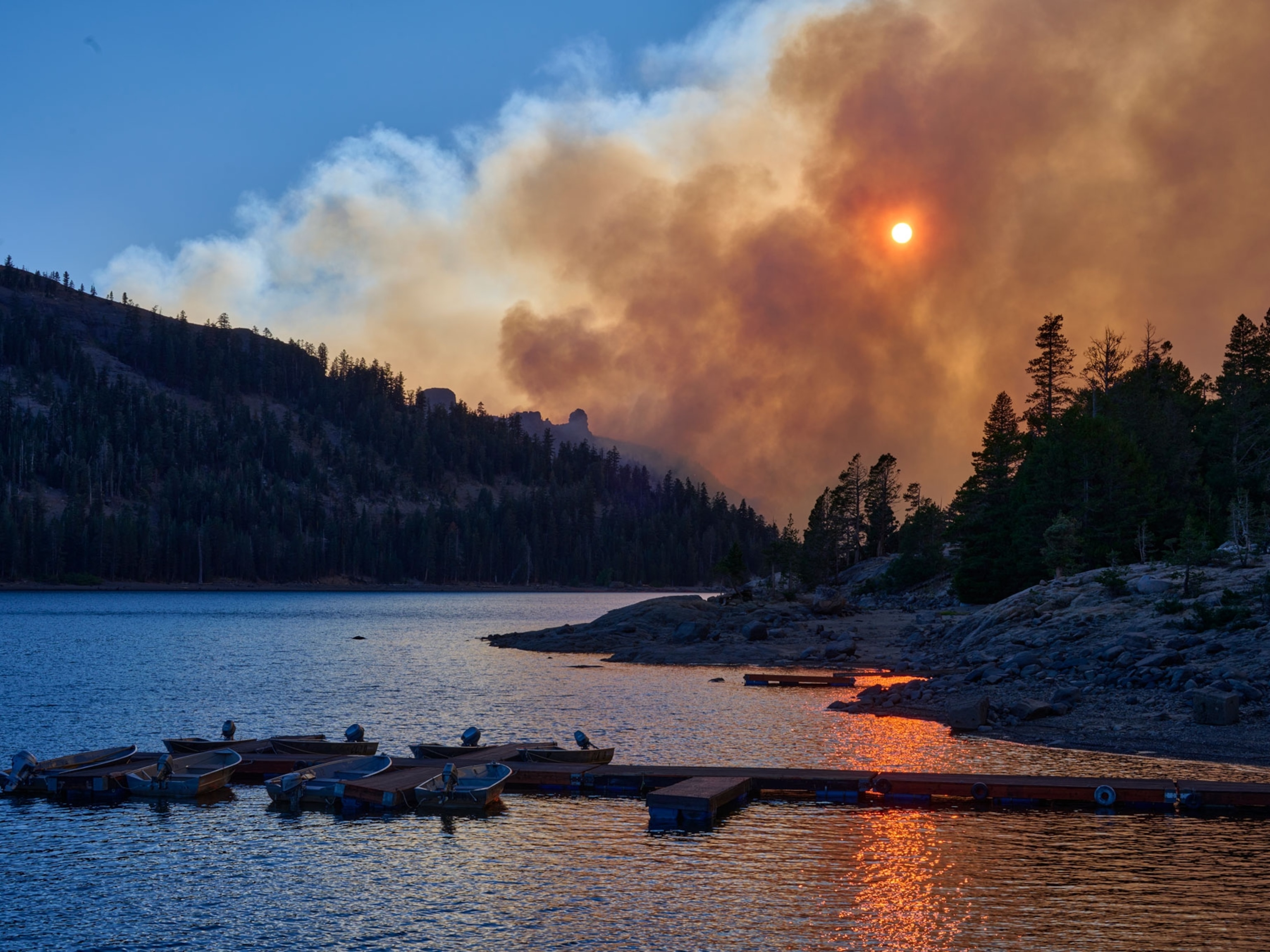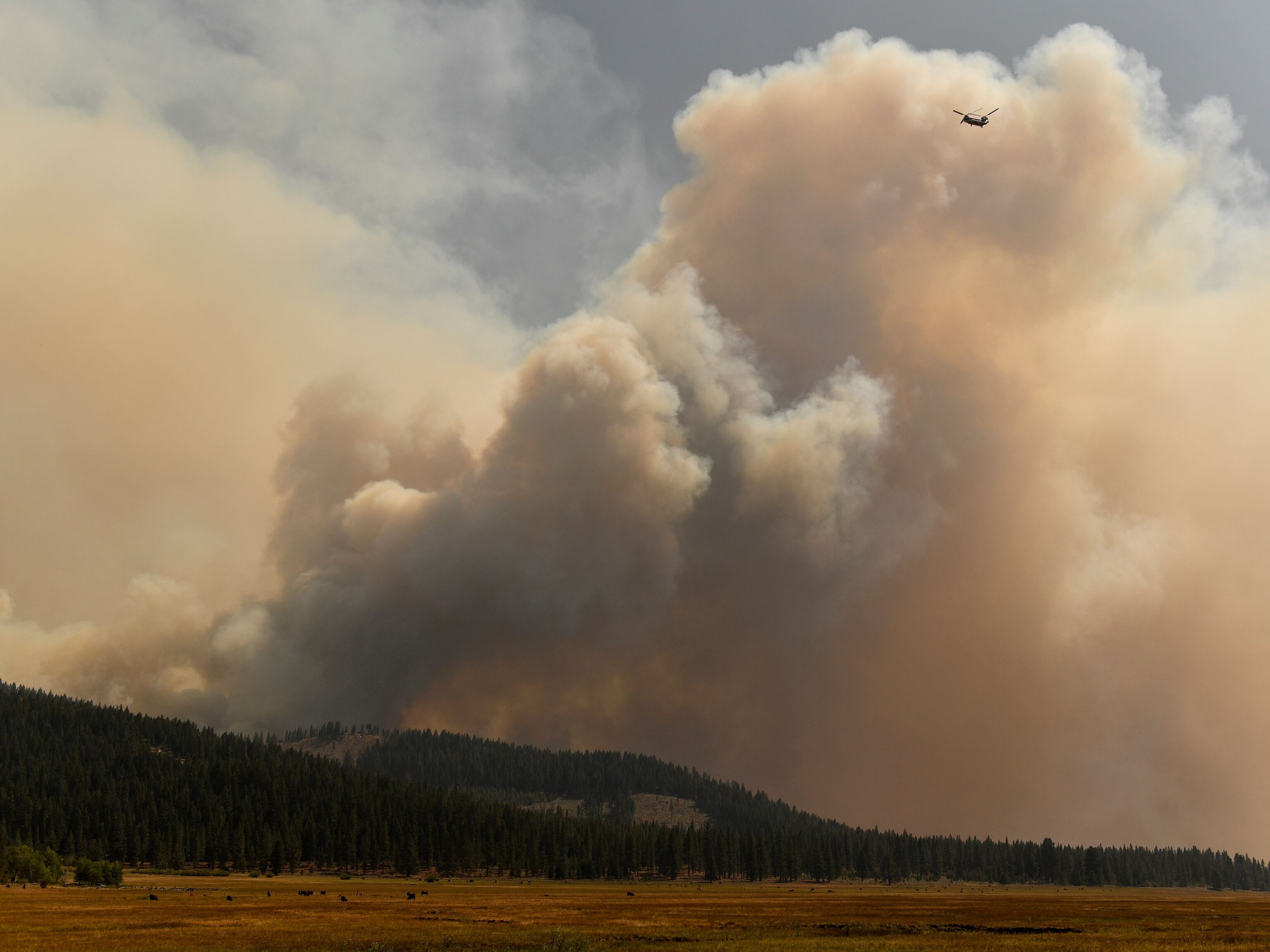
Wildfire smoke blowing across the U.S. is more toxic than we thought
Wildfires are threatening homes on the West Coast and in Canada, but their smoke is polluting air as far away as New York.
From his uptown Manhattan home in Morningside Heights, Samir Kumar can usually see skyscrapers downtown. But this week, as smoke from wildfires raging in the western United States and Canada rode the jet stream to the East Coast, the city skyline was blurred out.
“To see wildfires have an actual effect on this coast…I was in disbelief,” says Kumar.
The 29-year-old is asthmatic, and as he ran errands in his neighborhood, he says the air felt thick. He experienced shortness of breath, tightness in his chest, and had to take bigger breaths, but he managed to stave off an asthma attack.
Kumar, whose family is from India, says he’s seen air quality that bad in New Delhi, but never in the United States.
Currently, nearly 300 wildfires are burning in British Columbia and about 80 are blazing through states in the U.S. West. The fires are exacerbated by heat waves and prolonged drought in the west, two weather patterns made more extreme by climate change.
The largest fire now is Oregon’s Bootleg Fire, which as of Friday had burned more than 400,000 acres—an area nine times the size of Washington, D.C., where air quality alerts were also issued. Hazy skies reached from Boston to North Carolina. The far-flung impacts highlight that this is no longer just a problem for states like California, where wildfires have been more common.
Research published last January in the Proceedings of the National Academy of Sciences shows that, during a large fire event, wildfire smoke can account for 25 percent of dangerous air pollution in the U.S.
“What they’re experiencing on the East Coast from our West Coast fires shows it’s a nationwide and a global problem,” says Mary Prunicki, the director of air pollution and health research at Stanford University.
What we know about wildfire smoke
Each plume of smoke resulting from a wildfire is a unique mixture, from the types of trees burned to buildings or other objects that may have been incinerated by the blaze.
About 80 percent of the smoke is made of fine particulate matter composed of solid and liquid droplets from burned material, says Prunicki.
Because small particles penetrate a person’s lungs and lead to respiratory illnesses, scientists track particles of 2.5 microns in diameter, known as PM2.5, which are more dangerous than large sizes of particulate matter because they can pass into the bloodstream.
At that microscopically small size, a particle can lodge deep inside the body. Then the immune system kicks in with a response, releasing the same cells it would deploy to fight off a virus. The sustained immune reaction from regularly inhaling air pollution can affect everything from lungs to the liver or brain.
(Read more about how particulate matter in wildfire smoke affects the human body.)
For an otherwise healthy person exposed to such levels of smoke only briefly every year, the short-term threats beyond a scratchy throat or irritated eyes are relatively low, says Sarah Henderson, an environmental health scientist at the University of British Columbia.
But as the smoke spreads across the country and exposes millions of people, the health impact becomes more widespread among the most vulnerable. In addition to causing respiratory issues, air pollution can lead to poor heart health.
“I’ll often make the comparison to someone using cocaine,” says Henderson. “The risk of having a heart attack for someone who’s a cocaine user is high, but not many people use cocaine. Everybody is breathing the air,” and the health risks skyrocket when a greater number of people are exposed.
Those most at risk from wildfire smoke are people with respiratory conditions like asthma or COPD, a chronic lung disease, and pregnant women whose developing fetuses could be affected.
Levels of PM2.5 are measured by the Air Quality Index (AQI) on a five-tier scale. In New York City, the Tuesday AQI reached 154, a level at which it's unsafe for vulnerable people to breathe.
What’s more, smoke from wildfires could make it harder for people to fight off COVID-19 infections and the emerging variants because their immune systems are already battling pollution. Studies have shown that people exposed to air pollution are more likely to die from COVID-19.
“Any type of respiratory disorder or infection is going to impair your ability to fight other infections,” says Prunicki. “So if smoke causes a reaction now, when you’re hit with an infection, your body won’t be prepared to fight it.”
What we don’t know
There’s even more we don’t know about how airborne smoke affects the body. Last April, scientists detected traces of bacteria and fungi traveling in smoke. Wildfire smoke has been linked to Valley fever, a type of fungal infection, but it’s unclear which other disease-causing microbes may be present in smoke and how far they can travel.
A study published in Nature Communications in March found that exposure to wildfire PM2.5 drove up hospitalizations by as much as 10 percent from 1999 to 2012. Exposure to other sources of PM2.5, however, drove hospital visits by just over one percent.
“Our study is one indication that wildfire PM2.5 might be more toxic” than other sources of PM2.5 from sources such as cars, says Rosana Aguilera, an atmospheric scientist at the University of California San Diego and one of the study’s authors.
Exactly why it might be more toxic is unclear.
Earlier this month, the California Air Resources Board (CARB) published an analysis of the thick smoke produced from the state’s 2018 Camp Fire, which burned 150,000 acres, torched 19,000 buildings, killed 85 people, and destroyed the town of Paradise.
Smoke lingered for nearly two weeks in northern California and reached San Jose and Modesta, about 150 miles away. In the smoke were dangerous levels of metals like manganese, zinc, and, most worryingly—lead.
The high levels of lead persisted for 24 hours, making it difficult to link to specific ailments, but lead exposure has been linked to cancer and reproductive issues in adults and developmental problems in children.
“We can’t tie this short-term exposure to a specific health effect, but we can say lead is very dangerous, and there’s no safe exposure,” says Bonnie Holmes-Gen, the Health and Exposure Assessment branch chief at CARB.
Even more toxins may be lurking in wildfire smoke from fires that burn through neighborhoods, consuming homes containing manufactured items such as electronics, insulation, and plastic.
In March, scientists at the University of California, Davis identified toxic molecules in ash left behind from 2017 California wildfires. There were also many molecules they couldn’t identify, says Irva Hertz-Picciotto, an epidemiologist and director of the university's health science center.
In an ongoing study, Hertz-Picciotto has found that in addition to respiratory symptoms such as coughing, wheezing, or asthmatic episodes, people affected by smoke report high rates of stress and anxiety.
“Evacuations, seeing your home burn down—there’s a lot of trauma,” she says. “Mental health aspects can include post-traumatic stress disorder (PTSD). People can suffer from flashbacks.”
For the first time in its history as a state, California’s population is declining. Falling birth rates, high housing prices, and high taxes have been factors for years, and COVID-19 has exacerbated the trend, delaying planned moves into the state. Many survivors of wildfires have also chosen to rebuild in different states.
“If I was starting to raise children... I probably would leave this state,” says Hertz-Picciotto. She plans to spend several weeks during the height of wildfire season in August away from her home in northern California, where wildfires have become common.
Reducing air pollution from wildfire smoke in California and the rest of the country will require reducing the number and size of wildfires themselves. Lawmakers have introduced legislation aimed at better managing forests, training more firefighters, and making infrastructure more fire resistant.
“Ultimately until we stop burning fossil fuels, I don't see why it’s not going to get worse. It certainly can’t get better,” says Hertz-Picciotto.
Without addressing climate change, extreme heat and drought will create conditions for wildfires and the unhealthy smoke now stretching across the country, affecting people like Samir Kumar in New York City.
“I used to think about working in India, and one of the main deterrents was air quality. I might have to make a similar decision here,” he says.
How can you protect yourself from wildfire smoke?
The key to coping with wildfire smoke is to have a plan, says Stanford’s Mary Prunicki.
“Know you can’t rely on smell,” she says.
Use the online air quality index at AirNow.gov to see if pollution is rising in your zip code or monitor the air outside your home with an air quality monitor. If you’re able to purchase an air purifier, use it in just one room (more on that from the EPA). Make sure windows and doors are sealed to keep dangerous air out. For those suffering from conditions like asthma, ensure all prescriptions are filled.
Wildfires can strike quickly. Learn how to prepare here.
Related Topics
You May Also Like
Go Further
Animals
- Orangutan seen using plants to heal wound for first timeOrangutan seen using plants to heal wound for first time
- What La Palma's 'lava tubes' tell us about life on other planetsWhat La Palma's 'lava tubes' tell us about life on other planets
- This fungus turns cicadas into zombies who procreate—then dieThis fungus turns cicadas into zombies who procreate—then die
- How can we protect grizzlies from their biggest threat—trains?How can we protect grizzlies from their biggest threat—trains?
- This ‘saber-toothed’ salmon wasn’t quite what we thoughtThis ‘saber-toothed’ salmon wasn’t quite what we thought
Environment
- What La Palma's 'lava tubes' tell us about life on other planetsWhat La Palma's 'lava tubes' tell us about life on other planets
- How fungi form ‘fairy rings’ and inspire superstitionsHow fungi form ‘fairy rings’ and inspire superstitions
- Your favorite foods may not taste the same in the future. Here's why.Your favorite foods may not taste the same in the future. Here's why.
- Are the Great Lakes the key to solving America’s emissions conundrum?Are the Great Lakes the key to solving America’s emissions conundrum?
- The world’s historic sites face climate change. Can Petra lead the way?The world’s historic sites face climate change. Can Petra lead the way?
History & Culture
- Meet the ruthless king who unified the Kingdom of Hawai'iMeet the ruthless king who unified the Kingdom of Hawai'i
- Hawaii's Lei Day is about so much more than flowersHawaii's Lei Day is about so much more than flowers
- When treasure hunters find artifacts, who gets to keep them?When treasure hunters find artifacts, who gets to keep them?
Science
- Why ovaries are so crucial to women’s health and longevityWhy ovaries are so crucial to women’s health and longevity
- Orangutan seen using plants to heal wound for first timeOrangutan seen using plants to heal wound for first time
- Should you be concerned about bird flu in your milk?Should you be concerned about bird flu in your milk?
Travel
- 5 of Uganda’s most magnificent national parks
- Paid Content
5 of Uganda’s most magnificent national parks - On this Croatian peninsula, traditions are securing locals' futuresOn this Croatian peninsula, traditions are securing locals' futures
- Are Italy's 'problem bears' a danger to travellers?Are Italy's 'problem bears' a danger to travellers?







